The Line of Bottom
Monday 30th May 2016. I enjoy the new BBC film of A Midsummer Night’s Dream, as adapted by Russell T Davies. Maxine Peake is Titania, Matt Lucas is Bottom. Both are perfectly cast. Ms Peake already has that angular face one finds in Victorian paintings of fairies, while Mr Lucas brings cuddliness to the pompous Bottom even before he acquires the ass’s head (and then he really is cuddly, like a giant soft toy).Â
It’s made with the same team as Mr Davies’s Doctor Who productions, the ones with Christopher Eccleston and David Tennant. I’d say it’s especially like the Davies mini-series just before that: the David Tennant Casanova. It’s that same feeling of a fizzy, dressed-up world operating on a line of tension, with a progressive approach at one end – deliberate anachronisms, multi-ethnic casting, gay characters – and an embracing of popular entertainment at the other. This latest take on Shakespeare went out at 8.30pm on BBC1, so it had to appeal to as many people as possible. Yet it still had Davies’s personal vision at its heart: a world where fascist flags are ripped up into party decorations, where love comes in all shapes and sizes, and everyone dances to Bernard Cribbins singing ‘It Was A Lover And His Lass’. Can’t argue with that.
For all the liberties taken with the story – such as Theseus as a fascist dictator with an iPad – it’s difficult to say it’s any more radical than an average modern stage production. Since I visited the British Library’s Shakespeare exhibition, I’ve been reading about the Peter Brook 1970 RSC Dream, with its minimalist white squash court, stilts and trapezes. Birkbeck Library has two books about that production alone: a detailed making-of account by David Selbourne, and an RSC script with all the stage directions, where one can study Brook’s decisions line-by-line. His Bottom, for instance, merely gains a red nose when transformed by Puck. If a modern production has Bottom with ass’s ears, as in the BBC one, it’s still more traditional than Brook.
In the press there was a slight fuss about the BBC Titania kissing Hippolyta. This is nothing new. I read that the current Globe production of Midsummer Night’s Dream has Helena as a gay man called Helenus, with Demetrius as his lover in denial. The Globe’s previous Dream three years ago had Puck and Oberon passionately kissing. That particular Puck was played by Matthew Tennyson, a very pretty young man who happens to be a descendent of the Tennyson. He now pops up in the BBC film as Lysander, with a pair of glasses that rather makes him resemble Harry Potter. I read that as a deliberate nod to the way Shakespeare has direct links to popular culture now. If it uses the English language, it’s connected to Shakespeare.
I’ve also just remembered that there’s a lesbian bar on the Charing Cross Road, called Titania.
***
I’m going through my untidy piles of old papers, with a rule of throwing out five things every day. Discarding the ephemeral is easier when you realise it gives more value to the things you keep. And yet I do like the physical evidence of a life; the proof that whatever I’ve done, I’ve lived.
Today, with my head full of thoughts of A Midsummer’s Night’s Dream, I find a couple of letters from Dad that reference that very play.
They’re written on the backs of his own photocopied cartoons. One has a tiny Puck flying around the shoulders of two American comic book superheroes. Or rather, two versions of the same superhero, The Flash. One is the 1940s Golden Age Flash, with the winged hat; the other is the later Silver Age incarnation, with the one-piece costume and the mask.
Puck is saying: ‘I will put a girdle around the Earth in forty minutes‘. The two Flashes reply, ‘Been there, done that!’
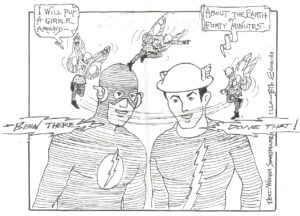
Dad’s other cartoon has a tiny Titania offering a rose to Mr Spock from Star Trek. Says Titania: ‘Come sit thee down upon this flowery bed / While I thy amiable cheeks do coy / And stick musk roses in thy sleek, smooth head / And kiss thy fair large ears, my gentle joy.’
Mr Spock, who of course has ‘fair large ears’, replies, ‘Fascinating!’.
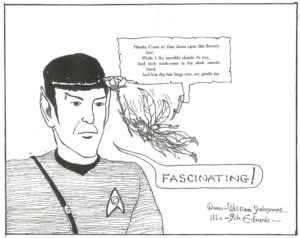
***
Friday 3rd June 2016. I find a Dutch newspaper supplement from late 2007, where I’m the cover star. Well, that’s if the cover of a supplement counts as a cover. It’s for an article on Modern Dandies of London (I think). Me alongside Sebastian Horsley, with his two fingers up to the camera. I still live in the same room, albeit with different curtains.
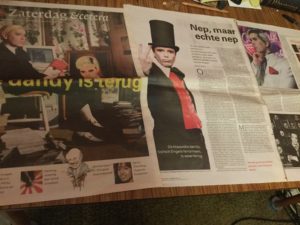
***
More mopping-up of unpublished activity.
Friday 6th May: While people have stopped me in the street to ask me why I hadn’t written more about the death of Prince, no one has yet chided me for my complete omission of the London mayoral election. Perhaps that sums up what sort of diarist I am.
Still, it needs to be said that I did indeed vote. Voters had a second preference, so I gave my first choice to the Greens’ Sian Berry, and my second to Labour’s Sadiq Khan. Khan triumphed, his victory announced late into the night of the 6th (after an agonising delay of many hours). Ms Berry came in at an impressive third, after the Conservatives’ Zac Goldsmith. She also took up a seat on the London Assembly, thanks to the Greens doing well enough on the ‘London-wide’ polling sheets.
It’s the first election result in years where I’ve felt optimistic about the future.
***
Films seen recently:
Tuesday 17th May 2016: Green Room at the ICA. £3. A horror thriller with the unusual backdrop of a right-wing skinhead music scene, in contemporary rural Oregon. Rather different to the Portland liberals of that same state, as spoofed in Portlandia. But then I suppose it’s analogous to the way parts of Sussex can be rather less progressive than Brighton.
Imogen Poots’s character has one of those skinhead-scene girls’ haircuts that flatter while adding a certain toughness: long at the sides with a sharp fringe at the front (a Chelsea Fringe? a Feathercut? not sure). The boots and braces look for the men is well-researched too – straight out of 1970s Britain, but jostling here alongside iPhones and American accents. Much significance given to the colour of laces in DMs. A couple of the scenes are extremely gory. But then it is meant to be a horror film too. I suppose boxes must be ticked in plot, in the same way that the characters must tick boxes with their clothes, their taste in rock music, and with their beliefs. These days, I find discussions about belonging thrilling enough; blood and violence less so.
Friday 20th May 2016: Heart of a Dog at the ICA. £3. Laurie Anderson’s stunning film essay, ostensibly about the death of her rat terrier Lolabelle, but touching on life and death in all kinds of ways, from the passing of friends and relatives, to the changes in New York after 9/11. Her husband Lou Reed’s death (which happened during the making of the film) isn’t explicitly referred to, but he’s there briefly as an actor (playing a doctor), and as himself (in footage of the couple on a beach). He also provides the closing song, and in the very last shot he is seen holding the dog.
At one point Anderson talks about that unhappy experience that most pet owners must endure: going to the vet to hear what she calls ‘The Speech’. The one that asks the owner if the pet can be put to sleep. It reminded me how I was recently told, separately, of the deaths of two cats I used to look after in North London: Claudia Andrei’s cat Sevig, and Jenn Connor’s Vyvian. When Sevig became very frail, Claudia pushed him around the streets of Edinburgh in a shopping trolley – ‘the Sevig-mobile’. After seeing Heart of a Dog I realised how lucky I was to have the pleasure of living with these beautiful creatures, without ever having to face The Speech.
Tuesday 24th May 2016: Troublemakers: The Story of Land Art, ICA. £3. A documentary on a group of artists in the late 60s and early 70s, who turned vast, desolate parts of the US into their own canvasses in the pure pursuit of Making Art. I was familiar with the Lightning Field artwork – all those lightning rods against the sky- but I hadn’t heard about works like Double Negative, where two gigantic rectangular chunks were carved out of a rocky mesa. According to the credits, some of the works begun in the 1970s are still in progress today.
Thursday 26th May 2016: Love and Friendship at the BFI. Free, courtesy of Tim Chipping, a fellow Whit Stillman fan (we went to see Barcelona together on its 1990s release). The film is followed by a Q&A with Whit Stillman, who is in typically eloquent and wry form. The film adapts Jane Austen’s Lady Susan, though there are touches of Wilde in Stillman’s script too. It’s verbose without ever being dry, and in terms of quips and jokes, it’s funnier than most modern comedies. My favourite film this year.
Friday 3rd June 2016: The Witch at the Prince Charles. £4. A tale of supernatural goings-on amongst a family of Puritan settlers, in seventeenth-century New England. Like Green Room, it blends the horror genre with more unusual aspects, in this case, gritty historical drama. The dialogue is lifted straight from the literature of the time: all ‘thy’s and ‘thee’s. As with Whit Stillman, the style only works once you realise what the director is trying to do: in this case, make a film that takes folk legends as real without question. It’s as if the film was made by seventeenth-century Puritans, as well as being about them.
***
A useful acronym from Atalanta K, who lost her bag after a night of carousing: ‘I had a CRAFT moment. As in: Can’t Remember A F-ing Thing.’
Tags:
a midsummer's night dream,
bbc,
Claudia Andrei,
dad,
dandies,
Dandyism,
films,
green room,
heart of a dog,
ICA,
jenn connor,
laurie anderson,
love and friendship,
Prince charles cinema,
Sebastian Horsley,
sevig,
shakespeare,
the witch,
vyvian,
whit stillman
Day of The Sherries
Saturday 10th January 2015. Work this week: writing the first draft of an essay. Escapism in Brideshead Revisited, Day of the Triffids and Lucky Jim. Much of which is escapism through alcohol. I was aware of the scenes of unrestrained drinking in Brideshead Revisited and Lucky Jim before I came to read them, but the booziness of Day of the Triffids surprised me.
Brian Aldiss called John Wyndham’s sci-fi novels ‘cosy catastrophes’. The term caught on, but it’s ultimately unfair, given the often frightening or even disturbing events Wyndham subjects his characters to. Still, Triffids certainly has an unexpectedly large amount of scenes where the hero stops for a drink, where one would expect him to do something rather more practical. The first ‘day’ of the story effectively reads like a post-apocalyptic pub crawl. After most of humanity has been blinded, Bill Masen reacts by walking around a silent London from bar to bar, helping himself to brandies and ‘restoratives’. He ends the day in a luxury flat drinking an ‘excellent Amontillado’. The woman he rescues along the way gets ‘a small Cointreau’. Day of the Sherries, more like.
The phrase that springs to mind is the title of Bevis Hillier’s book about post-war design, ‘Austerity Binge’. All three of the novels were published in the age of austerity, the 1940s and early 50s, and all three have scenes of what would now be called binge-drinking. Given rationing went on until 1954, it’s hard to begrudge the original readers for wanting a little cosiness with their catastrophe.
Three things which found a surge of popularity in 1940s Britain, as learned today from the Hillier book: circuses, canal boats and anything with a mermaid on it.
* * *
Sunday 11th January 2015. Over Christmas, some neighbours put a note through our door, asking if we’ve seen their lost cat. Missing since Boxing Day morning, it was a beautiful, exotically long-haired creature (a Maine Coon in fact). It would install itself in regal splendour on the top of the wall across the road. The sight of it would always cheer me up on my journeys into town. No sign of it since the note. Today I pass the wall and see a scratching post put out with the bins.
* * *
Tuesday 13th January 2015. To Birkbeck for a class on Maxine Hong Kingston’s Woman Warrior, her 1970s memoir of growing up as a Chinese American. Very unusual – the term ‘memoir’ doesn’t describe it properly, as it uses digressions into folktales, retellings of superstitions and family anecdotes retold in turn by relatives. Chinese whispers in every sense. The woman warrior in question turns out to be the mythical Fa Mu Lan, whom Disney turned into Mulan. We discuss Orientalism, which always reminds me of the imposing School of Oriental and Asian Studies building next door. It was founded in 1916 for the original orientalists, as in students of Asia, Africa and the Middle East. Thanks to Edward Said’s 1970s book, Orientalism, never far away from any college reading list, the word ‘orientalist’ now tends to mean a pejorative distortion of such cultures, especially by the West. I’m guessing they study that next door, too. It’s no surprise to add that the O-word has also been bandied about in discussions about Charlie Hebdo magazine this week.
* * *
Wednesday 14th January 2015. Class on Sylvia Plath’s Ariel and Ted Hughes’s Crow. I manage to read both in time, though the discussion of Plath takes up the whole seminar. No time for Ted. We listen to a radio recording of ‘Daddy’: I hadn’t realised how strong, confident and even sassy Plath’s voice was. At thirty, she sounds at least ten years older, not at all like the fragile waif I had imagined. I suppose what I really mean is that she doesn’t sound like the type to kill herself. Then I realise what a meaningless comment that is.
Still, her death will always inform any talk of her work. ‘Avoid biography’ is a common tip for literary scholars, ‘except when it’s Sylvia Plath’. With her it’s definitely ‘know the biography’. Biographies plural, too. New ones seem to pop up all the time.
Someone else in the class mentions that Frieda Hughes, the daughter, is a poet herself, and that she has her own pet owl.
Hughes’s Crow couldn’t be more different from Ariel. A rewriting of creation myths, giddying surreal vistas, unsettling shape-shifting tales of gods and universes. Plath bares herself, Hughes dissolves himself. I find both works intoxicating, though in different ways.
* **
Thursday 15th January 2015. More essay, more hours at the British Library. John Sutherland’s Lives of the Novelists is a dangerously addictive book. A doorstopper to dip into, it gives the reader potted biographies of hundreds of writers, and manages to include all the bits one really wants: gossip, love lives, anecdotes, myths, plus a decent smattering of criticism about the actual work. Mr Sutherland has his own preferences, however: there’s as much commercial fiction as there is Literature with a capital ‘L’. Jeffrey Archer makes the cut, Angela Carter doesn’t.
Interesting how some critics think Sebastian dies in Brideshead Revisited. He doesn’t. It’s Cordelia’s detailed prediction which muddles the memory. Sebastian simply drinks himself out of the text, last seen on a hospital bed in a Tunisian monastery. Also: a common error regarding The Day Of The Triffids. The mass blindness is not caused by a meteor shower. It in fact turns out to be the accidental triggering of a secret Cold War weapons system; or at least, that’s what the narrator decides. I mention this because today I read a piece on Wyndham which names and shames other scholars for making this error. A few paragraphs later, he himself gets the name of the main character wrong. Hubris in motion.
* * *
Friday 16th January 2015. I watch a YouTube video by Mark Kermode about misleading film marketing. The American DVD cover of Pride makes no reference to any of the characters being gay. Even the activists’ banner is airbrushed out. The director is fine with this, however, saying that’s it’s important to preach to the unconverted, and get a film seen by as many people as possible. The problem with this good intention is that it might backfire, leading to simple complaints of false advertising. This is nothing new, though. In the 80s, the US poster for Prick Up Your Ears tried to play down its gay theme, by crowbarring Vanessa Redgrave’s minor character into the white-toothed image of Gary Oldman and Alfred Molina. No sign of any connection stronger than friendship. More recently, the posters for Hanif Kureishi’s Le Week-End made it look like a fluffy romcom, rather than the simmering drama it really was.
But sometimes all the advertising in the world can make no difference, misleading or not. Some people only go to see a film because they’ve been dragged there. I witnessed this when I went to see The Hobbit Part One. As the lights went down, the man next to me said to his girlfriend, ‘I’ve no idea what this is about’.
Tags:
birkbeck,
evelyn waugh,
films,
john wyndham,
kingsley amis,
maxine hong kingston,
sylvia plath,
ted hughes
A Not-Young Man In A Hurry
Tuesday September 3rd. I turn 42 years old. The consolation of which is that thanks to Douglas Adams one now thinks about being the answer to life, the universe and everything. I always liked how for Mr Adams, turning 42 was the year he became a father.
I don’t have anything major planned for the next 12 months  – and certainly not parenthood – apart from doing another year of the English degree in Bloomsbury. That means I have to be in London two evenings a week. Other than that, I’m just on the lookout for the next thing, whatever shape that may take. A step up in my fortunes would, I’ll be honest, be highly agreeable.  I don’t just mean money, though of course I do mean money. In the meantime, I know I have to write, and that I must work on the writing, and that I must get the writing out there.
* * *
A birthday is really a celebration of the body; a renewal of life’s lease for another year. Since retiring from having birthday parties a few years ago, and in lieu of doing something pleasant with a companion (I am still single), I now see birthdays as an excuse to treat my body to a day trip. It’s as if to say thank you, O Body, for being around another year and not falling apart. I am lucky enough to still have working eyes, so it seems fair to give them new sights to see. I am also lucky enough to still have working legs, so it seems apt to give them new places to walk around. On top of that, I haven’t travelled much in recent years due to lack of income, so a day trip helps to make the birthday feel special. For my 40th I finally found out what Margate and Broadstairs were like, and for my 41st I explored Dungeness.
This year I decide on Eastbourne and the Seven Sisters cliffs, partly because there’s a one-off screening of Hitchcock’s Dial M For Murder 3D in nearby Brighton, and it’s a film I regretted missing in London. I’ve explored Brighton itself many times before, hence Eastbourne and the cliffs.
Eastbourne has a reputation as a retirement resort, and certainly the abiding sound of the town on my visit is the clack-clack of walking sticks mingling with the cawing of gulls. There’s a long row of benches on the promenade in front of a pretty floral display, pretty much all of them occupied by a senior citizen.

Surrounding oneself with the elderly in abundance on a 42nd birthday is a good reminder that, yes, 42 is older than young, but not properly old. Just not young. I don’t know what to do or feel about being 42, other than finding something to do and getting on with it. As a result, I march through Eastbourne in a state of impatience, knowing I have not just the cliffs and the cinema still to do, but life still to do. I am a not-young man in a hurry.
I’m enormously annoyed to find the Victorian camera obscura on the pier is closed indefinitely, despite the assurances to the contrary by the brand new Rough Guide To Kent, Sussex & Surrey. First published May 2013, it says, and evidently already in need of an update. I rest in the bar at the end, where there are huge TV screens on the walls tuned to the BBC news channel. News is now literally end of the pier entertainment.
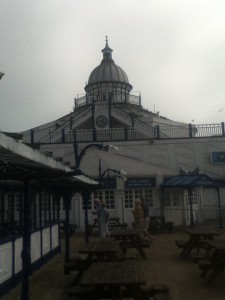
Then to the Museum of Shops, which thankfully is open and consists of agreeably cluttered recreations of shop interiors from the last century, presided over by some spooky mannequins in costume. There’s a wealth of obsolete brand names on all the vintage packaging, their extinction rendering them exotic. The most unusual exhibit has to be the midwife’s scissors used to cut the umblical cord of the infant DH Lawrence.
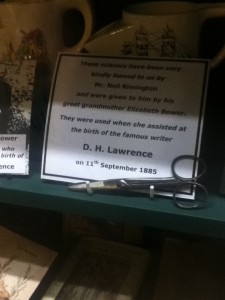
I take the 13x bus up on the cliffs past Beachy Head and the Belle Tout lighthouse (remembered from The Life and Loves Of A She-Devil) , but decide against getting off and taking a look as there isn’t time – clearly one needs to put aside a whole afternoon for cliff walking. As it is, a thick fog has suddenly appeared, blowing along the road in Hammer Horror fashion as the double-decker takes the steep climb from the town. By the time the bus is level with the cliff edge, the sea has disappeared into the grey altogether. I get off at the Golden Galleon pub by Exceat Bridge as planned, and walk the mile and a half footpath to Seaford Head, hoping the fog will lift. It doesn’t. So I get to see the coastguard cottages – the ones Mr McAvoy and Ms Knightley disappear into at the end of Atonement – without the cliffs behind them. Still, the salt marshes and chalk grassland of the Cuckmere Valley are pleasing enough.
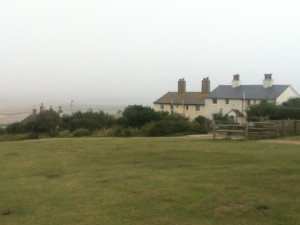
After about another couple of miles of fog walking along Seaford Head – carefully observing the ‘Cliff Edge’ signs all the time, and following an unpleasant encounter with an army of flies who take a liking to my linen suit – I feel I’ve done enough exercise to last me the week.
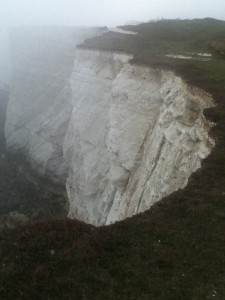
I walk into Seaford town and take the train to Brighton, always enjoying a single platform terminus of a branch line: the satisfying neatness of seeing where a lone railway track comes to a halt.

The moment I get off the train at London Road, close to 6pm, the fog has cleared. It’s a sunny late summer evening. A three-legged black cat crosses my path, and somehow that’s Very Brighton.
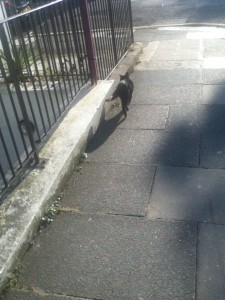
My spirits immediately lift; I often sense where I feel more at home, and bohemian, progressive Brighton is one of those places.
At the Duke Of York’s Picturehouse, Hitchcock’s Dial M For Murder turns out to be almost Wildean in style. Well-dressed people in a room being very arch and elegant with each other, thinking through all the complicated outcomes of their cunning plans, and adjusting them when things go wrong. The detective has a moustache comb, and uses it. One completely understands Mr Hitchcock’s choice to use 3D here: to make a stage play come alive without crowbarring in new locations for the sake of it. Grace Kelly’s stunning red evening dress therefore becomes even more stunning – I like the idea of 3D couture.
The discussion on 3D in films afterwards turns out to be with the man off the BBC1 film review show, the one who isn’t Claudia Winkleman, plus a film lecturer from Birkbeck, fittingly. Both are very much pro-3D in the interests of artistic experimentation, but admit there’s currently the problem of the extra darkness, the awkwardness of wearing glasses, and the greediness of cinema chains who hike up ticket prices for 3D films. I ask them to comment on Baz Luhrmann’s citing of Dial M For Murder as the main reason he shot The Great Gatsby in 3D. Mr BBC says he doesn’t care for Mr Luhrmann’s style full stop, while Mr Birkbeck confesses he didn’t see the Gatsby film for the same reason. Taste in artistic style will always come before taste in technology.
* * *
All of which discussion applies to my outing on the following evening, Weds 4th September.  I go to the Odeon Holloway to see the new documentary on the boy band One Direction, also in 3D. Anna S comes with me, and we use the popular Orange mobile offer, where you get two tickets for the price of one. This still costs us £8.50 each, and we go in whispering ‘How much?’ to each other as if we were visitors to the city, up from the shires.
In the auditorium, there’s a group of girls who must be a little too young to attend the boy band’s concerts; 10 or 11 or so. Whatever age where girls learn pop lyrics and presumably pay to see their idols in a cinema, but who also run around while the film is playing, sometimes sitting down the front by the steps, sometimes sitting on the steps, sometimes sliding down the slope above the staircase. This behaviour is obviously not new for children down the ages, but what is new is that they do all this with mobile phones constantly in one hand. One girl goes from screaming whenever her favourite member appears on the screen, to fiddling with her phone, to taking photos of her friends in the cinema, to running up and down the aisle, and then singing all the words of the One Direction songs. It’s the mix of physical with the digital (her tweeting or whatever she’s doing) that most intrigues me.
Obviously I consider going out and asking the Odeon staff if they could do something about this disruptive behaviour. But I decide against it – I have to admit that they are the film’s target market, not me. I can’t even name all five of One Direction. I’m here because I’m curious about what it means to be a British pop star in 2013, and how One Direction are an old product (a boy band) with a new twist: they owe their success to this new hyperactive use of the Internet by their fans. The digital space empowers a band’s followers to come together in number like never before. I only wish their music was a little better: too much of their repertoire is utterly forgettable and bland. Take That and Girls Aloud managed to have manifestly decent songs, so there’s no excuse. (That said, I still have their ‘Best Song Ever’ in my head as I write this. Oh, what a giveaway…)
The film itself does use 3D to dazzling effect at times: a montage of family photos sliding over each other, for example, or Space Invader graphics flying around the band as they perform. But with the over-stimulated urchin girls of Holloway Road running around me, the 3D experience I take away is rather more vivid than the makers intended.
What with that and the benches at Eastbourne, I spend my 42nd musing on the ways the old and the young are meant to act in public. And I suppose I too conform to a stereotypical way of being my age: going to a panel discussion at an art house cinema, for goodness’s sake. And IÂ enjoyed it.
Tags:
3d,
brighton,
cinema,
eastbourne,
films,
hitchcock,
one direction
Slow Excavations
Once again, I find gaps in my diary impossible to properly fill. Skimming over the unrecorded seems unfair, but leaving it out altogether seems worse. Am constantly amazed how anyone else gets anything done at all. There seems so much to keep tabs on – literal tabs in the case of the Web. Other people manage to easily write things on Facebook AND Twitter AND update their Goodreads account AND top up their various portable gadgets with power and credit (something that constantly defeats me) AND presumably earn incomes as well. And many of these people have children and partners too! I frequently feel like I’m the slowest person on earth.
Archaeology:
Weds 22nd May – Last exam of the 2nd year, as in my BA English degree at Birkbeck. The exam was half on Chaucer’s Troilus & Criseyde, half on a selection from the renaissance plays we’d been studying. I chose The Tempest  and Eastward Ho!
I don’t feel at all confident of getting a decent mark for this last exam, as I’d spent most the time I’d hoped to spend on revising on instead writing the final two essays plus revising for the other exam. I ran out of not just time, but also energy and motivation. By the 22nd of May I was utterly drained and found it hard to care very much about memorizing the names and arguments of Chaucer critics.
On top of that the stress for the exams gave my first ever migraine. The week before the last exam the sight in my left eye suddenly failed completely. It stayed like that for about an hour. The GP packed me off to Moorfields A&E, as he couldn’t rule out something retinal that might need emergency surgery. Thankfully Moorfields and all their eye machines diagnosed a ‘bilateral’ migraine. I was told to lie down in a darkened room and avoid whatever it was that was causing the anxiety. So my exam revision suffered there as well.
I understand why universities still hold exams – they’re proof one can spontaneously come up with the goods without access to books or the internet. But I’m grateful that the rest of the course has the option of being exam-free. They just don’t agree with me.
After the exam, I celebrated with a few fellow students: Jasmine, Kim, Jon et al. Cheap drinks in the university bar, then a restaurant meal in Marchmont Street.
***
The good news is that my two last essay marks for the 2nd year were Firsts. I also received a First in my overall grade for the Narratives of the Body module, the first grade to actually go towards my final degree grade. I get the other two overall module grades of the 2nd year when the exam marks come in, sometime in late July.
Since then I’ve mostly been recovering from it all. Attended a brilliant talk by Philip Hensher on vocatives, an entertaining one by Will Self on his novel Umbrella and one by Alan Bennett at the ICA doing his usual ‘Evening With’ set-up. Also saw the new Star Trek  film (fun), and the new Great Gatsby movie in 3D (absolute heaven).
***
Read Clampdown, a new cultural studies book by Rhian E Jones on the effect of 90s UK music on class and gender. What’s unusual is that it focusses on the cultural meaning of Britpop from the personal yet highly academic perspective of someone who grew up with that music – the author. I think previous books on Britpop have tended to be either by people working as journalists at the time (John Harris), or by those who were involved in the music business (Luke Haines). People who were actually informed by that culture during their teenage years logically have a different take, one that is only now starting to emerge. In Ms Jones’s case she talks about the importance to her of Kenickie and Shampoo as signifiers of female agency. But there’s so many other points in the book: many of which just hadn’t occurred to me. I could argue with some of her conclusions, but then I was never a working class teenage girl in the 90s. It’s an essential text for anyone trying to make sense of that ludicrous era.
Tags:
birkbeck,
films,
great gatsby
The Everyman Taste
Today: I watch a little bit of the Olympics – the dressage final – but as curious as the sport is (horses trotting very precisely to music), I’m still uninterested in it all. Not even at a time when people who don’t usually watch sport are now in fact watching sport. And lots of it. But my taste seems immutable: I do not like sport. Pity, really. I take no pleasure in not sharing a common taste – no tiresome contrarian I.
On the subject of common tastes, I’ve just been watching a three part TV documentary, All In The Best Possible Taste with Grayson Perry. Mr Perry is shown visiting people in Britain from across the class divide, in order to portray them in a series of colourful tapestries. With the tapestries, he manages to pay homage to Hogarth’s Rake’s Progress as well as classic religious paintings, while commenting on 21st century social behaviour, sometimes affectionately, sometimes scathingly.
The programmes themselves rather offend my own taste in documentary making, however. They do that irritating magazine-like thing of having a montage of clips at the start as a kind of framing device, so nothing is ever a surprise. It’s a reminder that when an artist or expert becomes a TV presenter, unless they have a hand in the whole process and treat it like an equal artform (like, say, Jonathan Meades), they’re at the mercy of a formulaic director, one who thinks they know what people like in a documentary. Which is rather ironic when it’s meant to be discussing the nature of taste. Still, at least the series justified itself with the tapestries, by acting as a conventional advert for unconventional art.
Mr Perry has some interesting interpretations on what makes taste, and where taste comes from. He sees it as part of peer group aspiration, of wanting to belong yet also define oneself as an individual. In my case, my taste in Not Liking Sport isn’t any kind of deliberate choice at all. It’s entirely innate; I don’t like sport in the same way as I am left-handed. Some people might point to my schooldays for reasons – I was a classic swot who was good in the classroom but useless in the gym, and one whose parents also were not big followers of sport. But neither was I forced to not like it. There’s certainly no escaping being exposed to sport, particularly football.
And right now, liking sport is the best way to feel Not Alone. But while I’m pleased for the people who take pleasure from the Olympics, I still can’t join in.
Something I am following, however, is another well-publicised discussion on taste. Obligingly, the BFI’s Sight & Sound magazine has released its Best Films Ever According To Proper Critics list, which it only does every ten years. The big news is that Vertigo has toppled Citizen Kane from the #1 spot for the first time in 50 years. I enjoy reading all the ensuing articles, until I come across one particular piece in The Guardian that makes a couple of rather sweeping assumptions about the masses:
‘We’ve all used the clapping Orson Welles gif to punctuate Tumblr posts, but have you ever watched all of Citizen Kane?’
No to ever using the clapping gif, yes to watching all of the film. I suppose that makes me officially too uncommon for The Guardian.
Tags:
films,
grayson perry,
olympics,
taste
Films: Avengers Assemble; Barbaric Genius
The sun has been white-hot; perfect weather for hiding in air-conditioned cinemas. Though, as I found out, this is something of a minority view.
Saw Avengers Assemble at the Muswell Hill Odeon. First screening of the afternoon, and I was the only person there. The film is enjoyable enough, though I felt rather acutely that it wasn’t made for the likes of me. I have a low tolerance level for big glossy fight scenes and battles, and was rather hoping the choice of director, Joss Whedon, would mean such scenes would be broken up with lots of snappy quips and self-aware banter; that was really what I went to see the film for. I’m a big fan of his work in the Buffy and Angel TV series, and enjoyed Serenity, his last film as a director.
As it turns out, though, the Avengers film does rather expect the viewer to be less of a Whedon fan and more of a Marvel fan, and particularly a fan of the recent Marvel films like Iron Man, Captain America and Thor, none of which I’ve seen. However, Tom Hiddleston as the villain Loki is particularly Whedonesque: arch in a fun way, hammy but in a knowing way. It seems slightly unfair that a team of superheroes has to fight a single supervillain, as it means the screen time for each hero is necessarily reduced, while Loki gets to do scenes throughout. Though it’s no spoiler to say that the goodies beat the baddie, in terms of attention the baddie ultimately triumphs.
Then the next day to see Barbaric Genius at the Odeon Panton Street. First screening of the day, but this time there was another sunshine-dodger in the cinema. And I enjoyed Barbaric Genius about twice as much as Avengers Assemble too: it’s rather more my sort of thing. A low-budget, feature-length Irish-made documentary, it tells the story of John Healy, a London-born Irishman who survives an abusive childhood and years of sleeping rough in London to become – unexpectedly – a chess champion and then an acclaimed author. His late 80s memoir The Grass Arena is hailed by some critics as one of the greatest autobiographies full stop. But then the rags-to-riches story goes into reverse. He falls out with the publishers (Faber), they force his book out of print and – the film alleges – he becomes blacklisted by the London literary establishment. He writes other books, but no publisher will touch them.
One theory is that, despite his writing talent, Healy’s background and class prevents him from properly connecting with the city’s very middle class literary world. But although the film is very much on Healy’s side, it doesn’t let him off the hook. In the film, he mocks the cut-glass tones of the woman who phoned him to say he’d won the JR Ackerley Prize for Autobiography. A publishing chief who doesn’t come across well is contrasted with a perfectly kind woman at Faber who liked him as a person – even when he was making threats of violence – and tried to protect him. A young man at Penguin also comes out well: in 2008 he reads The Grass Arena, and gets it republished as a Penguin Classic. The point is made that a good book deserves to be read, and once an author has proved their worth, their unpublished work should at least be given a chance.
Seems strange to note, but the technical quality of Barbaric Genius is actually superior to Avengers Assemble, at least in terms of the screenings I attend. The Avengers flick is in 3D, and I’m frequently irritated by bits of fuzziness and out-of-focusness that appear on the screen, presumably some sort of 3D side-effect. Perhaps it’s the Odeon Muswell Hill’s fault, or it’s to do with having to wear my own glasses underneath the 3D specs. Either way, it affects my enjoyment of the film, and I make a mental note to seek out 2D screenings next time. The novelty of 21st century 3D films has well and truly worn off. Not only does 3D add little to the filmgoing experience, but in cases like this it makes the experience worse.
That said, I’m looking forward to seeing the new Great Gatsby 3D, because it’s just the sort of film that one expects to not be made that way.
“So we beat on, boats against the current, borne back ceaselessly into the past… INTO YOUR FACE!”
Tags:
avengers assemble,
barbaric genius,
films,
reviews
Notes On Lean’s Twist
Tuesday last: to Birkbeck’s own Cinema to see David Lean’s Oliver Twist (1948). My first time in the cinema, and the first time I’ve seen – gotten around to, rather – the film.
(after a certain age, there’s an awful lot of getting around to things in one’s life… Have to remember that life is more than just a long To Do list – that implies one knows exactly what one wants from life, which is never true…)
The Birkbeck Cinema is really a 70-seat screening room used by various film societies, rather than a popcorn or arthouse venue with a regular daily programme (the smallest single-screen cinema in Central London proper is the Aubin, Shoreditch, as I found out last year). But a lot of the Birkbeck screenings are open to the public – and free, too. Currently there’s a programme of Dickens On Screen, hence the Lean Oliver Twist this week. Others in the programme are listed here, including a 1913 silent version of David Copperfield.Â
The cinema is tucked inside Birkbeck’s Gordon Square campus, a row of knocked-through houses that were once home to Virginia Woolf and co. But what’s unexpected is that the architecture around the cinema suddenly transforms from nondescript white Victorian corridors into a riot of multi-coloured 21st century geometrical shapes:



A little research reveals that the cinema was designed by Surface Architects, opened in 2007, and won a RIBA award.
The highlight of the David Lean Oliver Twist for me is the opening five minutes. The film opens on a desolate moor at night, with the horizon framed at a sharp geometric angle (much like the Birkbeck Cinema decor). Nothing for a few seconds, then a figure appears in the distance. Close up – it’s a pregnant young woman, alone, possibly lost, walking uncertainly along a muddy track. She sees a light in a building far off, smiles in relief and walks more quickly. Then a terrifying thunderstorm breaks, she’s caught in the rain, clings to a tree, and her face is contorted in pain as the lightning flashes:
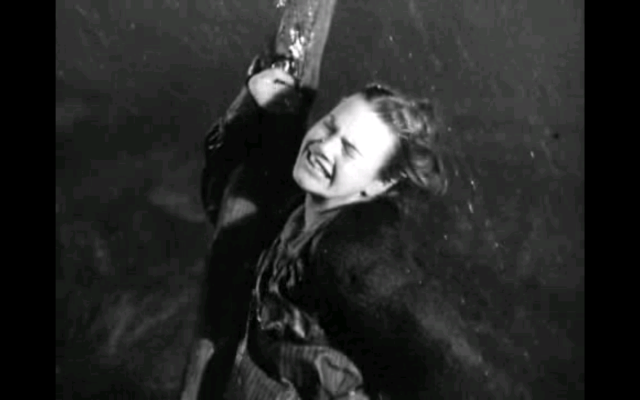
But she struggles on towards the light, makes it to the building’s front gate and is let in by someone from inside, carrying a lantern. As she disappears within, the camera pans up the building to reveal a sign in the wrought iron… “PARISH WORKHOUSE”.

It’s such a perfect opening. And this whole sequence is entirely wordless. It’s not in the novel, strictly speaking, based instead on a suggestion by Lean’s wife Kay Welsh (who plays Nancy in the film). But Dickens would surely approve. He didn’t know it at the time, but he was writing a story that would become not just a classic, but a myth, so a big mythical opening is called for. In fact, any version of Oliver Twist that begins with Oliver’s mother-to-be staggering to get to safety is taking its cue from Lean. It also has echoes of Yeats’s line about something ‘slouching toward Bethlehem to be born’.
(Actually, the beginning of the 2009 Star Trek movie has Captain Kirk’s mother in a similar situation, except in space…)
Tags:
birkbeck cinema,
david lean,
dickens,
films,
oliver twist
Part Crowd
I’m currently kitten-sitting in Golders Green, on and off for the next couple of weeks while the owners are abroad. Here’s a photo of the feline in question. Breed: Birman. Name: Piccadilly. Born in March.

In the hope of teaching him autonomous amusement, I’ve set him up with a couple of cardboard boxes from the local supermarket. But his favourite toy seems to be me. He has yet to learn that my trousers are not built for his teeth & claws. The owners have given me a water spray with which to teach him such boundaries, but it seems to have little effect. Either he’s one of those cats who like water, or he’s a bit of a masochist when it comes to suit-trouser love. ‘Yea, though the water jets may come, I will battle on to embrace my true beloved, The Trousers.’
I’ve been meaning to upload photos of myself from a session by Kim Cunningham. Here’s one. Taken May 2011 in Pond Square, Highgate:

Photographer credit: Kim Cunningham. www.kimcunningham.co.uk
This week: to the Everyman Baker Street cinema to see Bridesmaids. Produced by Judd Apatow, written by its star Kristen Wiig, and touted in the press as a rare mainstream comedy ‘chick flick’ that appeals to both genders. Which essentially means there’s a lot of broad slapstick and bad taste humour. Like Mr Apatow’s Knocked Up, however, it suffers from an unwieldy duration and insistence on pushing the jokes aside to end with some very traditional Hollywood moralising. I really wanted the touch of unpredictable anarchy of, say, Muriel’s Wedding or Romy & Michele’s High School Reunion. Still, the jokes are good enough, particularly the scenes of one-upmanship by Ms Wiig and her more glamourous, richer rival.
A matinee screening, with about ten people in the audience. Normally this would be quite a nice way to see a film – on the big screen in a proper cinema, with as few other people as possible to risk distractions. In fact, Bridesmaids is one of those films that does need a packed room of people. Otherwise one risks what happened with me – laughing aloud by myself in a room of strangers. For comedy films, one needs to laugh along with others.
For this reason, I rarely go to live comedy shows by myself. Stage & cinema comedy is unfinished without a crowd of friends and partners.
Tags:
cats,
cinemas,
comedy,
films,
gallery
Made In Balham
Last Tuesday: I make the pilgrimage to Balham. Although it’s my first visit, I share some DNA with the area: it’s the birthplace of my paternal grandfather. I’m there to visit The Exhibit, London’s smallest cinema. There are just 24 seats, comprising 12 highly comfortable sofas on raked steps. Ideally one needs to bring a friend, or risk sharing a sofa with a stranger.
The tickets are only £5, and they include a free bowl of popcorn. The Exhibit has a regular programme of second-run films not yet out on DVD (I see Made In Dagenham), and there’s a proper lit-up marquee sign above the entrance, making it feel more like a cinema, less like a screening room.
Made In Dagenham is a colourful dramatisation of the late 1960s women’s strike at the Ford motor factory. It’s an important history lesson, but the film keeps the politics balanced with plenty of humour and pathos. Miranda Richardson is particularly good as Barbara Castle.
What with this and The King’s Speech and The Social Network however, I find myself bristling at the inevitable captions at the end, telling you how important the events you’ve just seen are, and what the real people did next. They never tell you which bits have been invented for the sake of the story. I’ve found out myself that Sally Hawkins’s heroine in Made In Dagenham and Zuckerberg’s pivotal girlfriend in The Social Network are completely made up. This week I find myself yearning to see something entirely possible, but entirely fictional. No historical events, no science fiction or ballerinas turning into swans. Just for once.
So this Monday I go to the Prince Charles cinema (£1.50) to see – what else – Another Year, the latest Mike Leigh. It depicts a contented couple who live in suburban London and tend to their allotment, when they’re not tending to their various unhappy friends and relatives. Immaculate acting, particularly from Martin Savage as the bitter and violent Carl. He only has a couple of scenes late into the film, but it’s a part better realised than many leads. A world away from the camp scriptwriter he played in Ricky Gervais’s Extras.
Though it’s an ensemble piece, the film’s most memorable role is Lesley Manville’s Mary: selfish, complaining, frequently drunk, dominating the conversations. A typical Mike Leigh woman, though a very believable one. Like many of his films, I think enjoying Another Year depends on whether you’d enjoy meeting the characters in your own life. I preferred Happy Go Lucky and Career Girls for this reason. When the maternal Ruth Sheen finally mutters ‘Mary’s a bloody nuisance,’ I have to agree.
Another Year couldn’t be more different to the last film I saw at the Prince Charles, Inception. Inception is heavy on ideas but thin on characterisation, while Another Year is ALL characterisation and next to no story. And yet both films are engrossing and original and succeed according to their own rules. It goes to show that having a ‘three act’ plot arc or well-realised characters is only important where it’s important.
I say this because I’ve just applied to do a BA degree course in Creative Writing, at Birkbeck. If I’m accepted, it means two evenings a week from October onwards. As I’ve not taken a degree or student loan before, it seems I’m eligible for full state funding.
I’ve never had a university degree before, and after much pondering I’ve found out that I’d like to have one. Or at least, see if I can get one. Can only do me good. I still need an actual job, but this is a step in the right direction.
Tags:
films,
studies
Four Films: How To Change Shape
Catching up with more films, and enjoying spotting how different directors handle the same themes. In this case, metamorphosis.
Inception. Seen at the Prince Charles cinema for £2.50. It’s by Christopher Nolan, and has his very recognisable style: masculine disorientation, confusing battle scenes, a Borges-esque preference for ideas over characterisation, intellectual coldness, aesthetically pretty actors in sharp suits. No sex scenes, no silliness, no mucking about. Though Tom Hardy does sneak in a little camp aside. During a siege, he suddenly produces an oversized weapon and tells Joseph Gordon-Levitt, ‘You’ve got to dream a little bigger, darling’.
One location is meant to be Mombasa, but anyone who’s been to Tangier will recognise the very Moroccan Grand Socco and medina, with a few Kenyan drapes. I’m quite pleased about this. I may not always follow what’s going on in the film, but I know now that I can spot Tangier in disguise.
What I would like to know is why Mr Nolan couldn’t just set these scenes in Tangier anyway, given the city’s association with Westerners escaping into dreams. The two main literary biographies of Tangier even allude to this in their titles: Michelle Green’s The Dream at the End of the World and Iain Finlayson’s Tangier: City Of The Dream.
Even Nolan’s special effects are in keeping with his clean, non-silly style. Tom Hardy’s character has the ability to change into other people, though while other directors would reach for CGI morphing effects or a touch of latex, Nolan chooses to cut simply to a mirror, then back again. Transformation done.
No such luck for the protagonist of District 9, which I watch on DVD while staying in Suffolk with my sci-fi loving father (February 3rd-7th). I also see Avatar while I’m there. Both films have the human lead turning into an alien: Avatar’s hero gets an instant and entirely wished-for change into a beautiful blue humanoid. District 9‘s anti-hero, meanwhile, becomes one of the film’s Lovecraftian and tentacled ‘prawns’, and does so very slowly and very reluctantly, with gooey prosthetics (fingernails coming off) added to CGI. If the aliens of one film swapped with the aliens in the other, the stories would be entirely different.
Avatar uses sci-fi to address colonialism and invasion, while District 9 does it for immigration and apartheid. The military in both cases is the enemy, and there’s a lot of White Racial Guilt to read between the lines. It’s such a shame, though, that they both end with up with the standard Hollywood Final Battle between lone hero and lone villain, both with an Exo-Suit.
Finally, I see Black Swan at the Muswell Hill Odeon. I’m happy to report that Natalie Portman does not have to deal with an Exo-Suit in the finale. But conveniently for this diary entry, she does undergo a transformation into The Other which combines elements of all of the above.
She gets the revulsion of shedding fingernails from District 9, the glances of change in mirrors from Inception, and the smooth, beautiful CGI of Avatar for the final scenes of consenting change. Most impressive of all are the fluid ripplings of flesh to feather that are actually choreographed to go with the ballet music. Angela Carter would have loved it.
Black Swan is vastly enjoyable: a histrionic horror film that’s been cunningly smuggled into Oscar territory. And as I’ll always prefer dance scenes to shoot-outs, it’s my favourite of the four.
Tags:
avatar,
black swan,
district 9,
films,
inception,
metamorphosis






















